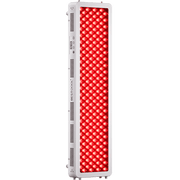Red light therapy no doubt hastens recovery, diminishes pain, reduces inflammation, and enhances athletic ability in tennis.
Tennis is a sport that expects agility, power, and endurance to come together for more successful performance. Whether the aim is to increase recovery or heal injuries, the role of RLT has evolved critically to be vital for any athlete who wishes to stay in the most excellent condition.

What is Red Light Therapy?
Definition and Explanation of Red Light Therapy
Red Light Therapy (RLT) is a phototherapy method that uses very low levels of red or near-infrared light in order to penetrate the skin, influence cellular processes in their functioning and promote repair and healing reactions. The light stimulation generated through this therapy helps eliminate inflammation and speed up the processes of our bodies' natural recovery. RLTreputation, given its ability to alleviate pain, quicken recovery, and boost overall performance, is gaining repute in sports and wellness circles.
Red Light Therapy Mode of Action
RLT activates the mitochondria, which are the energy centers of the cell, leading to increased ATP production. ATP is the energy currency of the cell; hence, with its enhanced production, the cellular ways of repair are hastened through RLT. With inherent anti-inflammatory properties, increased circulation, and rapid healing of tissues, red and near-infrared light therapy makes an incredible healer for the athlete.
Top Health Issues That Tennis Players May Encounter
Due to physical strain that exceeds normal boundaries that players experience, tennis athletes are prone to various injuries and health concerns. Let us explore the key conditions that can be treated with red light therapy.
1. Elbow Injuries
The most prevalent repetitive strain injury is tennis elbow (lateral epicondylitis), a cyclically repeating motion, particularly the backhand one, which has been performed with athletes. It causes pain and swelling around the elbow. Golfer's elbow is another condition caused by excess motion and arises within the elbow.
2. Muscle Strains and Sprains
Strains and sprains are the most common kinds of harm that typically befall tennis players, particularly muscle tears and ligament problems, usually in the legs, back, and arm areas. These injuries generally occur when the players overexert themselves in heavy rallies or do not warm up properly.
3. Wrist and Hand Injuries
Injuries in the wrist and hand, such as tendinitis or sprains, can be caused by swinging the racket numerous times along with frequent racket holding.
4. Foot Problems
The most prevalent foot problems faced by tennis players are plantar fasciitis, also known as heel pain, blisters, and various stress-related injuries, which result from pivoting and sudden movement on hard surfaces.
5. Overuse Injuries
Injury cases resulting from pushing the body too hard without adequate recuperation time often include stress fractures, tendonitis, and bursitis among players.
6. Psychological Stress
The mental aspect is as important as the physical aspect of tennis. Stress, anxiety, and mental fatigue will hamper one's performance on the court, causing indecisive and tense behavior as well as decreased focus.

Improving Tennis Techniques and Movements with Red Light Therapy
1. Improving Serve Technique
Serve as an important shot in tennis. It requires explosive power and a very precise technique. RLT has potential as a great enabler of muscle recovery post serves, thereby speeding up the recovery process with improved power and accuracy for the players.
2. Optimizing Stroke Mechanics
The stroke mechanics of a tennis player are really critical to their overall performance. Improper technique would be inefficient, as much as causing injuries. RLT would help in optimizing stroke mechanics through muscle tension reduction and flexibility improvement.
3. Enhancing Movement Ability and Agility
Tennis is a fast-paced, agile sport with quick directional changes. RLT can help recover from heavy session activity and develop agility over time.
4. Strengthening Core Stability
Combine with Other Common therapy
The red light therapy effect could be potentially enhanced by combining it with other natural therapies.
1. Cryotherapy and Thermotherapy
Cryotherapy reduces acute inflammatory symptoms, and heat therapy increases blood flow and flexibility. Both of the therapies will enhance their actions when combined with RLT to promote faster recovery.
2. Ultrasound Therapy
It is a method in which sound waves are used to penetrate and effect healing within a deep tissue. RLT, when applied along with ultrasound therapy, accelerates the recovery phase of tennis players post-injury.
3. Massage Therapy
Massage therapy generally relaxes muscles, calms the tension, and improves blood flow through the body. When coupled with red light therapy, massage can further optimize muscle preparation for performance and amplify recovery.
Conclusion
Red light therapy is going to completely change the lives of tennis players as far as the game goes, both physically and mentally. It really helps with quick recovery, pain relief, and reduced inflammation, allowing a player to come back to a game stronger and mentally focused. Red light therapy serves as an all-encompassing physical regimen that lends grace in time-increases endurance, and performance levels better than ever, and, of course, keeps the body away from injury. Red light therapy is not just about recovery but, it also brings the stunning transformation for a player right ahead of the game that can easily lift the performance of a tennis player to ultra levels.
References
- Glass GE. Photobiomodulation: The Clinical Applications of Low-Level Light Therapy. Aesthet Surg J. 2021 May 18;41(6):723-738. doi: 10.1093/asj/sjab025. Erratum in: Aesthet Surg J. 2022 Apr 12;42(5):566. https://pubmed.ncbi.nlm.nih.gov/33471046/
- Foley J, Vasily DB, Bradle J, Rudio C, Calderhead RG. 830 nm light-emitting diode (led) phototherapy significantly reduced return-to-play in injured university athletes: a pilot study. Laser Ther. 2016 Mar 31;25(1):35-42. https://pmc.ncbi.nlm.nih.gov/articles/PMC4846838/
- Borges LS, Cerqueira MS, dos Santos Rocha JA, Conrado LA, Machado M, Pereira R, Pinto Neto O. Light-emitting diode phototherapy improves muscle recovery after a damaging exercise. Lasers Med Sci. 2014 May;29(3):1139-44. doi: 10.1007/s10103-013-1486-z. Epub 2013 Nov 21. PMID: 24258312.














 Small
Small

 Moderate
Moderate

 Moderate
Moderate

 Moderate
Moderate

 Full
Full



